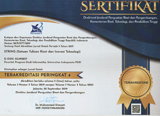Sistem Informasi Geografi dan Penginderaan Jauh dalam Pemetaan Zona Longsor Lahan di Kawasan Terbangun
(1)
(*) Corresponding Author
Abstract
Landslide is a natural hazard that is quite widespread throughout the world and has caused casualties and ruined people's economic livelihoods. This study uses qualitative and quantitative methods combined with a spatial approach to analyze primary and secondary data from satellite imagery, observation, and related agencies. Data processing is conducted using Global Mapper 20, Arcgis 10.8.1 and Ermapper 8.1 softwares. The results obtained from this study show that the vulnerability to landslides is relatively high, with a large area around 51.63%. This area is spread over hilly areas. For built land, its level of vulnerability to landslide in both the high and very high categories, namely in zones Z-4 and Z-5, is caused by slopes of 25 to > 40%, with rock types with a high degree of weathering and with built-up land cover. The use of remote sensing and geographic information system in assessing landslide in the research area can be used as a guide for the proper use of land to avoid disasters that may occur.
Keywords
Full Text:
PDFReferences
S. Benchelha et al., Landslide susceptibility mapping in the commune of Oudka, Taounate Province, North Morocco: A comparative analysis of logistic regression, multivariate adaptive regression spline, and artificial neural network models, Environ. Eng. Geosci., vol. 66, no. 1, pp. 185200, 2020, doi: 10.2113/EEG-2243.
U. Arsyad, R. A. Barkey, W. Wahyuni, and K. K. Matandung, Karakteristik Tanah Longsor di Daerah Aliran Sungai Tangka, J. Hutan dan Masy., vol. 10, no. 1, pp. 203214, 2018, doi: https://doi.org/10.24259/jhm.v0i0.3978.
H. C. Hasibuan and S. Rahayu, Kesesuaian Lahan Permukiman pada Kawasan Rawan Bencana Tanah Longsor di Kabupaten Temanggung, Tek. PWK (Perencanaan Wil. Kota), vol. 6, no. 4, pp. 242256, 2017, doi: https://doi.org/10.14710/tpwk.2017.18072.
A. S. Nugroho, A. Aji, and A. Indrayati, Perubahan Penggunaan Lahan Sawah Menjadi Non Sawah dan Pengaruhnya terhadap Keberlanjutan Sawah Lestari di Kabupaten Klaten, Geo-Image, vol. 6, no. 2, pp. 139146, 2017, doi: https://doi.org/10.29244/jpsl.8.2.258-263.
C. S. Juang, T. A. Stanley, and D. B. Kirschbaum, Using citizen science to expand the global map of landslides: Introducing the cooperative open online landslide repository (COOLR), PLoS One, vol. 14, no. 7, pp. 128, 2019, doi: 10.1371/journal.pone.0218657.
T. H. Tran et al., GIS-Based Soft Computing Models for Landslide Susceptibility Mapping: A Case Study of Pithoragarh District, Uttarakhand State, India, Math. Probl. Eng., vol. 2021, 2021, doi: 10.1155/2021/9914650.
S. He, J. Wang, and S. Liu, Rainfall event-duration thresholds for landslide occurrences in China, Water (Switzerland), vol. 12, no. 2, 2020, doi: 10.3390/w12020494.
BNPB, Risiko Bencana Indonesia (Disasters Risk of Indonesia), Int. J. Disaster Risk Sci., p. 22, 2016, [Online]. Available: https://doi.org/10.1007/s13753-018-0186-5
I. A. Bhat, M. ul Shafiq, P. Ahmed, and T. A. Kanth, Multi-criteria evaluation for landslide hazard zonation by integrating remote sensing, GIS and field data in North Kashmir Himalayas, J&K, India, Environ. Earth Sci., vol. 78, no. 20, pp. 115, 2019, doi: 10.1007/s12665-019-8631-3.
J. P. S. Handoko and I. Ikaputra, Prinsip desain arsitektur bioklimatik pada iklim tropis, Langkau Betang J. Arsit., vol. 6, no. 2, pp. 87100, 2019, [Online]. Available: https://jurnal.untan.ac.id/index.php/lb/article/view/34791
M. A. Akbar, S. R. Utami, and C. Agustina, Simulasi Pengukuran Longsor Pada Kemiringan Lereng Dan Ketebalan Seresah Yang Berbeda, J. Tanah dan Sumberd. Lahan, vol. 9, no. 2, pp. 321327, 2022, doi: https://doi.org/10.21776/ub.jtsl.2022.009.2.12.
D. Cruden, Landslide risk assessment. Routledge, 2018.
M. S. Rompon and A. Almulqu, Identifikasi Dan Pemetaan Daerah Bencana Rawan Longsor Di Kecamatan Amarasi Barat Dengan Menggunakan Arc View Gis, Partner, vol. 23, no. 2, pp. 810821, 2018.
H. S. Naryanto, H. Soewandita, D. Ganesha, F. Prawiradisastra, and A. Kristijono, Analisis Penyebab Kejadian dan Evaluasi Bencana Tanah Longsor di Desa Banaran, Kecamatan Pulung, Kabupaten Ponorogo, Provinsi Jawa Timur Tanggal 1 April 2017, J. Ilmu Lingkung., vol. 17, no. 2, p. 272, 2019, doi: 10.14710/jil.17.2.272-282.
Q. Wang and W. Li, A GIS-based comparative evaluation of analytical hierarchy process and frequency ratio models for landslide susceptibility mapping A GIS-based comparative evaluation of analytical, Phys. Geogr., vol. 3646, no. March, p. 0, 2017, doi: 10.1080/02723646.2017.1294522.
BPBD, Longsor Terjadi di Sejumlah Titik di Kota Ambon, REPUBLIKA.CO.ID, AMBON, 2020. https://d.republika.co.id/berita/qcqo0a284/longsor-terjadi-di-sejumlah-titik-di-kota-ambon (accessed Jul. 30, 2020).
M. Z. R. Lavan Kumar, Sushanth, Manikanta, IRJET- Application of GIS in Investigating the Influence of Rainfall-Runoff on Landslides, Irjet, vol. 8, no. 6, pp. 36463653, 2021.
N. K. Tewari and A. K. Misra, Landslide vulnerability assessment in Gangotri valley glacier Himalaya through GIS and remote sensing techniques, Appl. Water Sci., vol. 9, no. 4, pp. 110, 2019, doi: 10.1007/s13201-019-0992-y.
S. Uvaraj and R. Neelakantan, Fuzzy logic approach for landslide hazard zonation mapping using GIS: a case study of Nilgiris, Model. Earth Syst. Environ., vol. 4, no. 2, pp. 685698, 2018, doi: 10.1007/s40808-018-0447-8.
A. S. Banuzaki and A. K. Ayu, Integrated Remote Sensing and GIS Analysis for Landslide Susceptibility Assessment along the TrenggalekPonorogo Road, East Java Province, Indonesia, Indones. Assoc. Geol. J., vol. 1, no. 1, pp. 3948, 2021, doi: 10.51835/iagij.2021.1.1.14.
L. Lombardo, T. Opitz, and R. Huser, Numerical Recipes for Landslide Spatial Prediction Using R-INLA. Elsevier Inc., 2019. doi: 10.1016/b978-0-12-815226-3.00003-x.
W. A. Gemilang, S. Husrin, U. J. Wisha, and G. Kusumah, Kerentanan Pesisir Terhadap Bencana Tanah Longsor Di Bungus, Sumatera Barat Dan Sekitarnya Menggunakan Metode Storie, J. Geosaintek, vol. 3, no. 1, pp. 3744, 2017, [Online]. Available: http://iptek.its.ac.id/index.php/geosaintek/article/view/2954
M. Marina, H. Indrawati, and S. Suarman, Application of Moving Class Learning Models and Teacher Pedagogical Competence on Learning Motivation and Student Learning Discipline, J. Educ. Sci., vol. 3, no. 1, p. 72, 2019, doi: 10.31258/jes.3.1.p.72-83.
R. Hidayat and A. A. Zahro, Identifikasi Curah Hujan Pemicu Longsor di Daerah Aliran Sungai (DAS) Serayu Hulu-Banjarnegara, 2018. [Online]. Available: http://hdl.handle.net/11617/10336
S. Devi, Use of Remote Sensing and GIS in Landslide Hazard Analysis, Int. J. Sci. Eng. Technol. Res., vol. 9, no. 1, 2020, [Online]. Available: https://d1wqtxts1xzle7.cloudfront.net/63158016/IJSETR
K. A. Ahmed, S. Khan, M. Sultan, U. Bin Nisar, M. R. Mughal, and S. N. Qureshi, Landslides assessment using geophysical and passive radon exhalation detection techniques in Murree Hills, northern Pakistan: Implication for environmental hazard assessment, J. Earth Syst. Sci., vol. 129, no. 1, 2020, doi: 10.1007/s12040-019-1327-y.
S. ellek, Effect of the slope angle and its classification on landslide, Nat. Hazards Earth Syst. Sci. Discuss., pp. 123, 2020, doi: https://doi.org/10.5194/nhess-2020-87.
S. Nengsih, Pengaruh Kadar Air Terhadap Kestabilan Lereng (Kampus Politeknik Negeri Padang), J. Ilm. Rekayasa Sipil, vol. 12, no. 2, pp. 3645, 2015, [Online]. Available: https://core.ac.uk/download/pdf/268097274.pdf
S. Ritung, A. F. Wahyunto, and H. Hidayat, Panduan evaluasi kesesuaian lahan dengan contoh peta arahan penggunaan lahan Kabupaten Aceh Barat, Balai Penelit. Tanah dan World Agrofor. Cent. (ICRAF), Bogor, Indones., vol. 45, 2007, [Online]. Available: https://www.worldagroforestry.org/publication/panduan-evaluasi-kesesuaian-lahan
S. Suwarsito, I. Afan, and S. Suwarno, Analisis Hubungan Kerawanan Longsor Lahan dengan Penggunaan Lahan di Sub-Das Kali Arus Kabupaten Banyumas, Sainteks, vol. 16, no. 2, pp. 129135, 2020, doi: 10.30595/st.v16i2.7130.
Hadiyanto, Pengaruh komposisi media organik terhadap pertumbuhan dan hasil tiga varietas jahe (Zingiber officinale Rosc.), 2011, [Online]. Available: http://repository.unej.ac.id/handle/123456789/23499
E. A. Heradian and Y. Arman, Pendugaan Bidang Gelincir di Desa Aruk Kecamatan Sajingan Besar Kabupaten Sambas dengan Menggunakan Metode Tahanan Jenis, Prism. Fis., vol. III, no. 2, pp. 5661, 2015, doi: ttp://dx.doi.org/10.26418/pf.v3i2.11878.
H. Soewandita, Analisis Kawasan Rawan Longsor Dan Keterkaitannya Terhadap Kualitas Tanah Dan Penggunaan Lahan (Kasus Di Kawasan Agribisnis Juhut Kabupaten Pandeglang), J. Alami J. Teknol. Reduksi Risiko Bencana, vol. 2, no. 1, p. 27, 2018, doi: 10.29122/alami.v2i1.2826.
B. Harjadi and P. Paimin, Teknik identifikasi daerah yang berpotensi rawan longsor pada satuan wilayah daerah aliran sungai, J. Penelit. Hutan dan Konserv. Alam, vol. 10, no. 2, pp. 163174, 2013, doi: https://doi.org/10.20886/jphka.2013.10.2.163-174.
A. Rahman, Penggunaan Sistim Informasi Geografis untuk Pemetaan Kerawanan Longsor di Kabupaten Purworejo, Sumber, vol. 5, no. 2500, p. 5, 2010.
R. Putra, H. Edial, and W. Prarikeslan, Studi Karakteristik Lahan Terhadap Longsor Di Kelurahan Balai Gadang Kecamatan Koto Tangah Kota Padang, Buana, vol. 3, no. 2, pp. 2934, 2019, doi: https://doi.org/10.24036/student.v3i2.417.
R. Y. Darmawan, D. Miswar, and I. L. Nugraheni, Analisis Daerah Rawan Longsor Di Kecamatan Limau Kabupaten Tanggamus, JPG (Jurnal Penelit. Geogr., vol. 9, no. 1, 2021, [Online]. Available: http://jurnal.fkip.unila.ac.id/index.php/JPG/article/view/22624
M. E. Fitrianingrum and D. Ruslanjari, Zonasi Rawan Longsor Di Desa Pagerharjo Kecamatan Samigaluh Kabupaten Kulonprogo Yogyakarta, Gea. Jurnal Pendidikan Geografi, Vol. 18, No. 2, 2018, doi: https://doi.org/10.17509/gea.v18i2.8481.
DOI: http://dx.doi.org/10.30998/string.v7i3.16161
Refbacks
Copyright (c) 2023 Mohammad Amin Lasaiba

This work is licensed under a Creative Commons Attribution 4.0 International License.
STRING (Satuan Tulisan Riset dan Inovasi Teknologi) indexed by:

Ciptaan disebarluaskan di bawah Lisensi Creative Commons Atribusi 4.0 Internasional.
View My Stats


 Sertifikat Akreditasi
Sertifikat Akreditasi
















